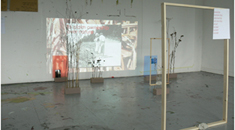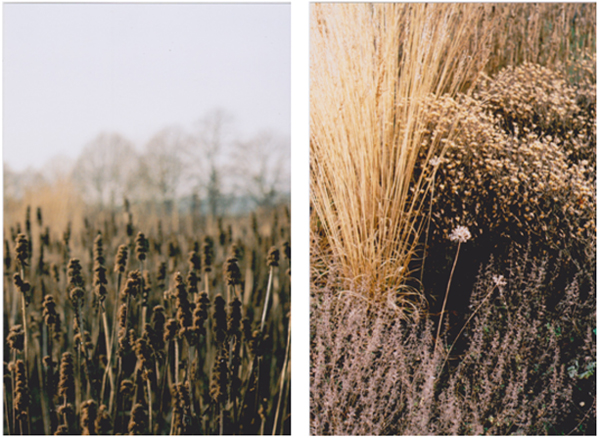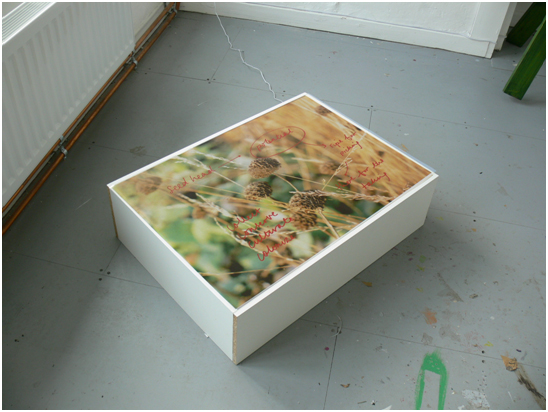By Annabel Duggleby, Fine Art: Print and Time-Based Media alumni,
Wimbledon College of Arts
Annabel Duggleby is a recent Fine Art: Print and Time-Based Media graduate from Wimbledon College of Arts and was selected for this year’s Art for the Environment International Artist Residency Programme (AER) Hauser & Wirth Somerset Residency. Here, she reports back on her residency experience.
In the cottage opposite Hauser & Wirth Somerset’s studio space is a small library crammed full of heavy, hardback art books. On my first night in my temporary home, I reach for one particularly thick volume that offers a survey of the gallery’s established artists, and the book falls open at a page where a previous resident has carefully pressed a smooth, elongated leaf from a pine tree. This small discovery feels like a gift, a secret piece of history left undisturbed for me to find. Despite their international standing, the gallery at Bruton in Somerset feels much like this: a gem tucked away in the picturesque English countryside.
I arrive in Bruton by train, on a frosty late-January afternoon and am greeted by Debbie and Dorcas from the Education Department, who give me a whirlwind tour of the small town I’ll be staying in for four weeks, before taking me to my studio and accommodation. The studio is called The Maltings, after it’s previous incarnation as a brewery and grain store, which links nicely to my area of research.
The project I proposed to undertake during the AER residency explores the commodification and objectification of nature by looking at two historical narratives: that of Victorian plant hunters, who travelled the world to find exotic plants for Britain’s burgeoning nurseries; alongside the more modern practice of seed patenting that is used by large agricultural companies to protect the intellectual property rights of their genetically modified seed varieties. I wanted to explore these narratives alongside each other as examples of ways in which scientists and botanists have attempted to exert power over nature, and have sought to take ownership over and categorize natural resources for profit. I was interested in working with the perennial meadow at the gallery, planted by renowned garden designer Piet Oudolf.
Oudolf’s garden utilizes perennial flowers such as Echinacea and Achillea alongside different grass varieties. He uses matrix planting: where varieties of plants that grow well together in dense patches form a self-sustaining and bio-diverse landscape, influenced by the prairie gardens and wildflower meadows of North America. A key feature of Oudolf’s planting style is that the garden remains visually interesting throughout the year, through his use of structure. The tall brown seed heads look equally as impressive in winter as they did in full bloom.
Luckily, I arrive just before the gardeners plan to cut back the garden, and so I am allowed to take cuttings to use in an installation.
I spent some time in the garden and in the local landscape, wandering, taking photos and writing observations. The rest of the time was spent at The Maltings, reading, researching and experimenting. Using some of the photos from the garden I created pieces that combine image and text as a way of working through ideas. A lot of my text pieces use wordplay and associations to find links and patterns between ideas. Using the wood workshop at the studio I made a light box to display an acetate print, which creates an interesting play between object and image, and speaks to ideas about the display and organization of knowledge.
One of my aims for the residency was to work through ways in which to combine moving image and three-dimensional objects. Inspired by Piet Oudolf, I began making compositions with acrylic panels, wood and real plants that mirrored the structure and colour palette of the perennial meadow.
I began working on a moving image piece that wove together photographs, text and video shot in the Oudolf garden, with found archival footage. I was motivated by a line from an interview with Berlin-based artists Pierwoss & Siska, that states “Both artists explore history as multi-layered and shifting”[i]. This informed the aesthetic of the piece, which layers imagery and sound from different time periods to explore the notion that the actions of past agents who traveled to, colonized and claimed landscapes are relevant to how we conceptualize and treat nature today. I think there is an interesting parallel in the practice of naming plants: using Latin as a scientific standard and including the name of the person who ‘discovered’ it, with the notion that you can patent a seed – a concept that relegates native farmers and animals outside the realm of culture, as actors who cannot control or create nature, but only work inside of it.[ii]
Whilst researching archive agricultural footage I came across a film from 1953 that told the story of how the discovery of oil affected the prairies in areas of North America. The voiceover and music is typical of the period and presents the story of those who settled in the region, as a heroic and idealized narrative: “They began with nothing but their bare hands and a bucket of hope.” For me this was an interesting example of biased accounts that put white western humans at the forefront of historical events. I also chose to use parts of this clip as it provided a link to the prairie plants that Piet Oudolf uses, but also highlights the contrast between these anthropocentric historical narratives and Oudolf’s matrix planting practice that encourages biodiversity and gives agency to non-human actors in the landscape.
At the end of the residency I presented my film and installation to the gallery staff and members of the public as part of an open studio event. It was good to talk with people about the piece after a period of sustained working, and I got some great feedback and suggestions from the gallery directors.
Watch Annabel Duggleby’s film ‘Ex Nihilo’ (2017) – created at her AER Residency at Hauser & Wirth Somerset:
Overall, the residency was a really positive experience and allowed me the dedicated time and space to work on this project. The staff at Hauser & Wirth were very supportive and always available, but also respectful of my need for space. I would definitely recommend applying for an AER residency as it provides a valuable stepping-stone from university to professional practice and has already helped me secure opportunities for the future.
More images of the work can be found at annabelduggleby.com.
[i] Partridge R. (2016) Pierwoss & Siska [Online]. Berlin: Berlin Art Link. Available at: http://www.berlinartlink.com/2016/12/19/pierwoss-siska/
[ii] Van Dooren T. (2008) Inventing Seed: the nature(s) of intellectual property in plants. Environment and Planning D: Society and Space 26, pp 676-697
The Art for the Environment International Residency Programme (AER):
In 2015, internationally acclaimed artist, Professor Lucy Orta UAL Chair of Art for the Environment – Centre for Sustainable Fashion, launched the Art for the Environment Residency Programme (AER), in partnership with residency programmes across Europe. Applicants can choose from a 2 to 4 week period at one of the hosting institutions, to explore concerns that define the twenty-first century – biodiversity, environmental sustainability, social economy, human rights – and through their artistic practice, envision a world of tomorrow.
Through personal research, studio production time, critiques and mentoring sessions with Lucy Orta and a selection of Europe’s most exciting cultural institutions, the residency programme provides a platform for creative individuals, working across various disciplines, to imagine and create work that can make an impact on how we interact with the environment and each other.
A distinguished selection panel will assess the applicants for this unique opportunity to partake in the UAL Art for the Environment Residency Programme.
NOTE: Applications accepted from UAL graduates, postgraduates and recent alumni (within 12 months from graduation date).






